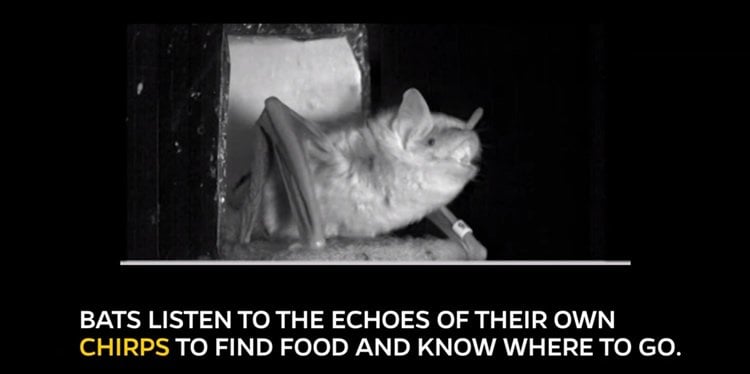You’re at a crowded, noisy party. The music is loud; multiple conversations are going on simultaneously. But when someone behind you says your name, you hear it and quickly turn in that direction.
The same sort of thing happens with bats, leading Johns Hopkins University researchers to discover how a bat’s brain determines what’s worth paying attention to. The findings, which have implications across animal systems, were published this month in Proceedings of the National Academy of Sciences.
“With so many stimuli in the world, the brain needs a filter to determine what’s important,” said Melville J. Wohlgemuth, the lead author and a postdoctoral fellow in JHU’s Department of Psychological and Brain Sciences. “The bat brain has developed special sensitivities that allow it to pick out sounds from the environment that are pertinent to the animal. We were able to uncover these sensitivities because we used the perfect stimulus—the bat’s own vocalizations.”
To navigate as they hunt in the dark, bats use echolocation—they make certain high frequency sounds as they fly, then listen for echoes bouncing off objects in front of them to orient themselves. The bat pays attention to some of these echo sounds, but not all of them, researchers say.

Wohlgemuth and co-author Cynthia F. Moss, a Johns Hopkins neuroscientist, wanted to figure out which sounds would be deemed “important” enough to evoke responses from neurons that are involved in orienting behaviors, such as turning towards a sound.
The researchers experimented with five big brown bats, playing them a variety of sounds while monitoring their midbrain activity. They played recordings of natural chirps, the actual sounds bats made as they hunted. They also played artificial white noise and sounds between the two extremes. All of the sounds were identical in amplitude, duration, and bandwidth.
Although sensorimotor neurons in the bat midbrain reacted to all of the sounds, the neurons involved in stimulus selection—those that guide orienting behaviors—responded selectively to a subset of the natural chirps.
“That’s really important because it showed that if a neuron reacts to all stimuli, any sound in the environment, it doesn’t do an animal any good,” Wohlgemuth said. “You need the selectivity.”
Because all mammals share a basic brain organization, these findings suggest for the first time how mammals, including humans, likely choose which stimuli deserve attention.
“Bats produce the sounds that guide their behaviors, and consequently, we know what signals are important to them,” Moss said. “By comparing activity patterns of neurons to biologically natural and artificial sounds, we learn general principles of sensory processing that apply to a broad range of species.”
Source: Jill Rosen – Johns Hopkins Medicine
Image Source: The image is adapted from the Johns Hopkins Medicine video.
Video Source: The video is available at the Johns Hopkins University YouTube page.
Original Research: Abstract for “Midbrain auditory selectivity to natural sounds” by Melville J. Wohlgemuth and Cynthia F. Moss in PNAS. Published online February 16 2016 doi:10.1073/pnas.1517451113
Abstract
Midbrain auditory selectivity to natural sounds
This study investigated auditory stimulus selectivity in the midbrain superior colliculus (SC) of the echolocating bat, an animal that relies on hearing to guide its orienting behaviors. Multichannel, single-unit recordings were taken across laminae of the midbrain SC of the awake, passively listening big brown bat, Eptesicus fuscus. Species-specific frequency-modulated (FM) echolocation sound sequences with dynamic spectrotemporal features served as acoustic stimuli along with artificial sound sequences matched in bandwidth, amplitude, and duration but differing in spectrotemporal structure. Neurons in dorsal sensory regions of the bat SC responded selectively to elements within the FM sound sequences, whereas neurons in ventral sensorimotor regions showed broad response profiles to natural and artificial stimuli. Moreover, a generalized linear model (GLM) constructed on responses in the dorsal SC to artificial linear FM stimuli failed to predict responses to natural sounds and vice versa, but the GLM produced accurate response predictions in ventral SC neurons. This result suggests that auditory selectivity in the dorsal extent of the bat SC arises through nonlinear mechanisms, which extract species-specific sensory information. Importantly, auditory selectivity appeared only in responses to stimuli containing the natural statistics of acoustic signals used by the bat for spatial orientation—sonar vocalizations—offering support for the hypothesis that sensory selectivity enables rapid species-specific orienting behaviors. The results of this study are the first, to our knowledge, to show auditory spectrotemporal selectivity to natural stimuli in SC neurons and serve to inform a more general understanding of mechanisms guiding sensory selectivity for natural, goal-directed orienting behaviors.
“Midbrain auditory selectivity to natural sounds” by Melville J. Wohlgemuth and Cynthia F. Moss in PNAS. Published online February 16 2016 doi:10.1073/pnas.1517451113






